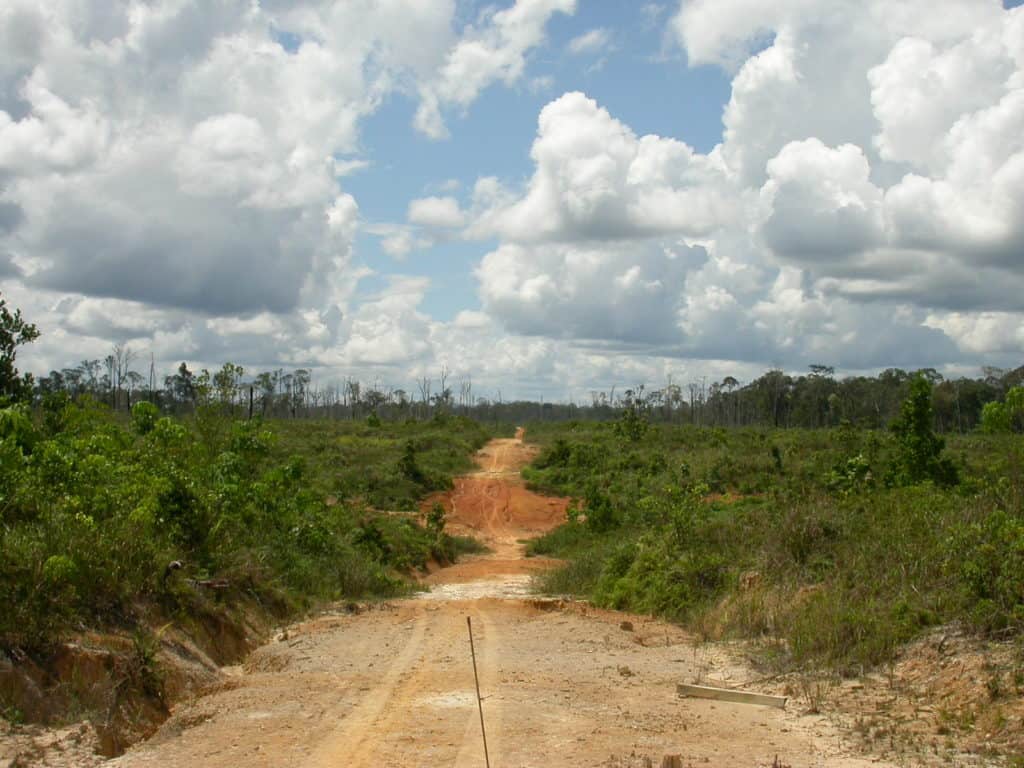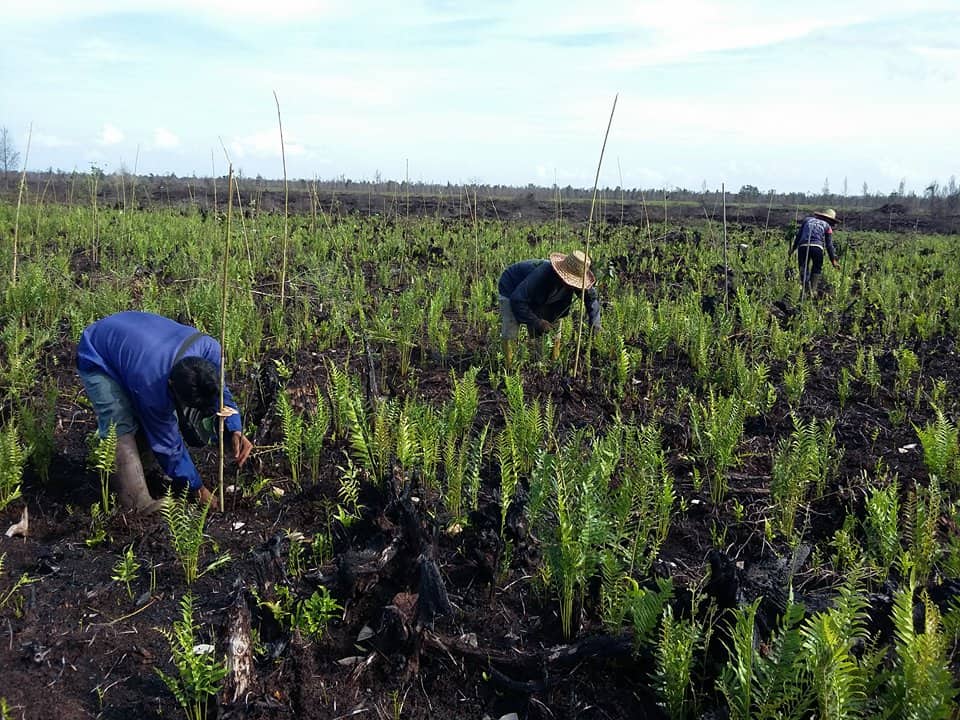A new report from IUCN concludes that the extensive deforestation of Borneo’s rainforests has exacerbated the global climate changes, and the orangutan is under greater pressure than previously anticipated. The report underlines the importance of taking climate changes into account in efforts to restore orangutan habitat. The report has identified a number of tree species both resilient to climate changes and preferred by the orangutan for nesting and food. Consideration to both the climate and the orangutan’s preferences contribute to the orangutan’s long-term survival.
A team of researchers from IUCN (International Union for Conservation of Nature) has just published a report with contributions from several representatives of our partners in Borneo, including BOSF-Mawas and BOSF-RHO. The report underlines the importance of taking climate change into consideration in orangutan conservation efforts. The report has been published in response to a significant exacerbation of the climate changes as a result of the extensive deforestation in Borneo. The report reveals that the critically endangered orangutan is under greater pressure than previously anticipated due to the exacerbated climate changes. Moreover, the report presents recommendations for future orangutan conservation projects in light of the new findings.

Borneo’s changing climate
When trees rot, are cut down, or burnt, the carbon they have stored is emitted into the atmosphere as CO2. The extensive deforestation in Borneo is thus the cause of a massive CO2-emission, contributing to global warming. In the report, IUCN estimates that 69-81% of orangutan habitat will have been destroyed between 2010 and 2080 as a result of deforestation – a 3-5 times bigger loss than previously estimated. Aside from a massive CO2-emission, deforestation also contributes to reduced precipitation since the number of trees absorbing water from the soil and vapouring it into the atmosphere has been reduced significantly.
Locally in Borneo, the deforestation has already resulted in higher daily temperatures and less daily precipitation as well as increased the frequency of extreme weather phenomena such as El Niño, bringing with it significantly drier weather. So far, El Niño recurs after 5-7 years and La Niña has occurred in between, bringing with it significantly wetter weather. More frequent El Niños will make Borneo’s climate even drier and hotter, and the droughts in Borneo will be longer.
The drier and hotter climate also results in an increased risk of more frequent and more devastating forest fires. The unique Bornean peat forests are especially fire prone as enormous amounts of CO2 is contained in its up to 20 metres thick layer of peat – CO2 that is stored as long as the peat is wetted. Draining of the peat has destroyed the ecosystem of several areas and resulted in large CO2-emissions. After the peat has been drained, it becomes flammable and the risk of large forest and peat fires is increased significantly. In turn, the fires contribute to even larger CO2 emissions which harms the climate.

The critically endangered orangutan is under greater pressure than previously anticipated
The climate changes have and will continue to have enormous consequences on Borneo’s biodiversity – and the critically endangered orangutan is under even greater pressure than previously anticipated.
The extensive deforestation, the drier and hotter climate, and the increased risk of more frequent and larger forest fires, which in turn destroy even more forests, lead to both habitat and food loss for the orangutan. Consequently, the orangutan is forced into small enclaves of the forest without enough food, or it is forced into closer contact with humans. This increases the risk of human-orangutan conflicts or of illegal trade in orangutans.

Making orangutan habitats climate resilient
Consequently, we have to focus on slowing down the climate changes and improving the orangutan’s survivability. One of the ways in which the challenges can be met is through forest protection and reforestation with considerations for both climate changes and wildlife. Reforestation poses a unique possibility to make a restored forest area more resilient to climate changes, illegal activities, and forest fires and more capable of supporting its wildlife – also in the long term.
IUCN’s report has a concrete focus on the Kutai National Park in East Kalimantan in Borneo, but it presents recommendations for future reforestation projects anywhere with consideration to both climate, forestry, and wildlife. By following IUCN’s recommendations, a long-term and sustainable restoration that will help conserve Borneo’s great biodiversity and restore orangutan habitats is ensured. That way, the orangutan also becomes more resilient to climate changes.
IUCN recommends investigating the area thoroughly to gain extensive knowledge on how the forest is used and what plants are important to its wildlife, for instance for nesting and food. This initial investigation is crucial since the food influences the health, well-being, reproduction, and behaviour of the orangutans in the area. The study identified seven tree species to be the most important orangutan trees in terms of nesting and food.
Because of the findings that the predicted climate changes have been exacerbated, IUCN also recommends obtaining knowledge on the forest area’s resilience to climate changes such as droughts and fires. This will ensure long-term and sustainable habitats. A resilience investigation, including an evaluation of different trees’ reproductive capacities, reactions to long droughts, and resilience to forest fires must be carried out. The study identified two tree species as being the most climate resilient.

IUCN’s recommendations are based on results from restoration efforts in Mawas and Samboja Lestari, carried out by our Indonesian partner BOS Foundation. The examples from Mawas and Samboja Lestari have created best practices for future reforestation efforts, including Save the Orangutan’s and our programme partners’ restoration projects.
Restoring Mawas’ peat forest – home to more than 2500 wild orangutans
Save the Orangutan has cooperated with BOSF-Mawas since 2015 to restore a peat forest area in Mawas to optimise the protection of the 2500+ wild orangutans in the area. The restoration efforts in Mawas have been shaped by BOS Foundation’s best practice restoration projects in Mawas and Samboja Lestari, which have been highlighted in the IUCN report. For the past 3 years, Save the Orangutan has supported restoration efforts in Mawas’ peat forest. The efforts in Mawas have yielded a great result with approximately 75 hectares, corresponding to more than 100 soccer fields, restored with more than 122,000 seedlings.
You can read more about our forest restoration programme here >>